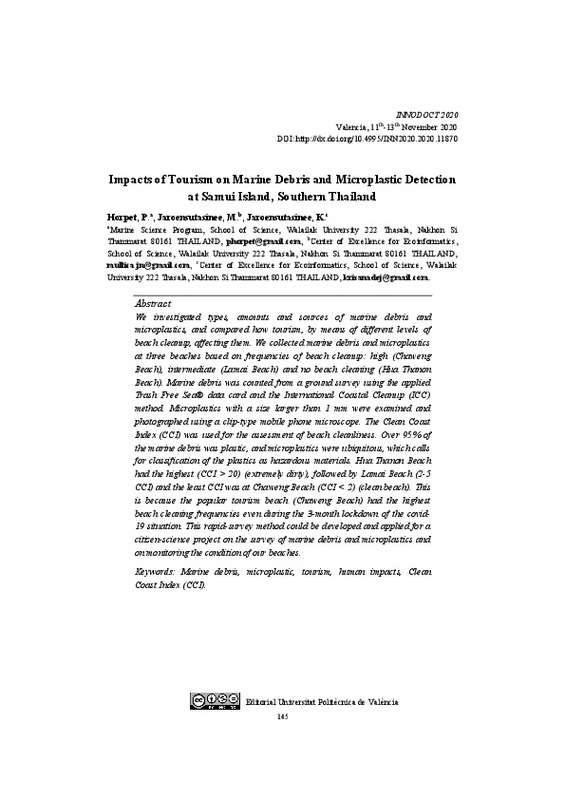JavaScript is disabled for your browser. Some features of this site may not work without it.
Buscar en RiuNet
Listar
Mi cuenta
Estadísticas
Ayuda RiuNet
Admin. UPV
Impacts of Tourism on Marine Debris and Microplastic Detection at Samui Island, Southern Thailand
Mostrar el registro completo del ítem
Horpet, P.; Jaroensutasinee, M.; Jaroensutasinee, K. (2021). Impacts of Tourism on Marine Debris and Microplastic Detection at Samui Island, Southern Thailand. En Proceedings INNODOCT/20. International Conference on Innovation, Documentation and Education. Editorial Universitat Politècnica de València. 145-153. https://doi.org/10.4995/INN2020.2020.11870
Por favor, use este identificador para citar o enlazar este ítem: http://hdl.handle.net/10251/162005
Ficheros en el ítem
Metadatos del ítem
| Título: | Impacts of Tourism on Marine Debris and Microplastic Detection at Samui Island, Southern Thailand | |
| Autor: | Horpet, Phusit Jaroensutasinee, Mullica Jaroensutasinee, Krisanadej | |
| Fecha difusión: |
|
|
| Resumen: |
[EN] We investigated types, amounts and sources of marine debris and microplastics, and compared how tourism, by means of different levels of beach cleanup, affecting them. We collected marine debris and microplastics at ...[+]
|
|
| Palabras clave: |
|
|
| Derechos de uso: | Reconocimiento - No comercial - Sin obra derivada (by-nc-nd) | |
| ISBN: |
|
|
| Fuente: |
|
|
| DOI: |
|
|
| Editorial: |
|
|
| Versión del editor: | http://ocs.editorial.upv.es/index.php/INNODOCT/INN2020/paper/view/11870 | |
| Título del congreso: |
|
|
| Lugar del congreso: |
|
|
| Fecha congreso: |
|
|
| Agradecimientos: |
We thanks Mr. David Chang for manuscript preparation, Miss Fahsai Thai-on, Miss Nittaya
Jaerem, Miss Hawa Phoonpherm, Miss Kanchanid Panjareon, Miss Chanunchida
Phitchayanitinai, students and teachers from Samsenwittayalai ...[+]
|
|
| Tipo: |
|








